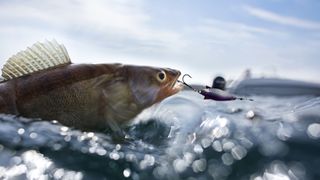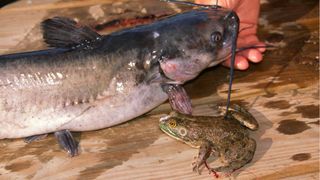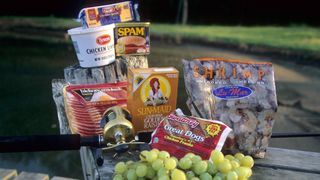How to choose fishing bait: what you need to catch more fish
There's so much you can put on the end of your hook. Here's how to choose fishing bait to target the fish you want to catch

How to choose fishing bait is a common question from novice anglers. When learning to fish, it’s easy to feel overwhelmed by all the bait options available. There are scores of enticements from which to choose, but you need to narrow the selection to just a few for each fishing trip.
No bait works every time, but the more you learn about using each one, the more fish you’ll catch. Let’s start you on the road to success by discussing some pointers for popular choices for fishing bait that works.
Live baits
Live baits include many forage animals that comprise the natural diets of our sportfish. Some like worms, minnows and crickets can be purchased in bait shops. Others like shad (small bait fish) or frogs aren’t often sold but can be collected outdoors if you have the proper gear and adequate time.
A decision on which to use often comes down to availability. Can I purchase this bait from my local bait dealer, or will I need to spend valuable time catching the bait before I start fishing? The answer may determine what works best for you.
Unless you fish with the bait right away, you’ll also need to utilize various methods for keeping it alive. Dead, stiff or glassy-eyed fish baits seldom are as enticing as those that swim, hop and wiggle. Some baits like nightcrawlers (big earthworms) and insect nymphs are easily kept in your refrigerator or a cooler until you go fishing.
But others such as minnows and shad may require specialized items like aerators to oxygenate the water or bait tanks for proper care. Use only those baits you know you can keep healthy until you reach your fishing hole.
You’ll also want to be sure you know all regulations governing the collection and use of live baits where you’ll be fishing. These often are extensive, and you’ll want to make bait selections based on what the law allows.
Advnture Newsletter
All the latest inspiration, tips and guides to help you plan your next Advnture!
For example, some states limit the use of baitfish to certain “Green List” species to help prevent the accidental introduction of unwanted types. Stick with legal varieties so you aren’t part of the problem.
Finally, you’ll want to match the bait you’ll use to the type of fish you’re hoping to catch. For example, you wouldn’t want to bait your hook with a frog if you’re hoping to catch bluegills because bluegills seldom eat frogs. In this case, crickets, a bluegill favorite, will work better. Those same crickets won’t work well for coaxing walleyes, but a fat night crawler or leech will prove irresistible every time.
Good live baits and fish they catch include:
- Worms: bluegills and other sunfish, trout, black bass (largemouth, smallmouth, spotted), catfish, walleyes, carp
- Minnows: crappie, black bass, catfish, walleye, trout, saugers, pickerel, white bass, salmon
- Crayfish: black bass, catfish, trout, rock bass
- Crickets/grasshoppers: bluegills/sunfish, crappie, trout
- Shad/herring: catfish, stripers, hybrid stripers, largemouth bass
- Frogs: black bass, catfish, pickerel, walleyes
- Leeches: walleyes, black bass, sunfish, catfish, trout
- Insect larvae (hellgrammites, mealworms, waxworms, dragonfly nymphs, catalpa worms and more): trout, sunfish, rock bass, black bass, walleyes, catfish, crappie
- Crabs/shrimp: saltwater sportfish such as redfish, black drum, tarpon, sheepshead, permit, jack crevalle, bonefish, cobia, pompano
- Bloodworms: bluefish, seatrout, striped bass, whiting, flounder, porgy, croaker, perch
- Sand fleas: pompano, whiting, blackfish, redfish, striped bass, black drum, croakers
- Eels: striped bass, tuna

- How to plan a fishing trip: all you need to know before you go
- How to go night fishing: all you need for a successful catch under the stars
- 10 of the best baits for winter fishing so you catch more when it's cold
Grocery baits
If you enjoy fishing for catfish and fresh live baits aren’t available, a trip to the supermarket could turn up some good enticements. We call these grocery baits. Good ones to try include:
- Hot dogs: especially cheap brands.
- Chicken liver: Fresh works better than frozen, the bloodier the better.
- Cheese: especially smelly varieties like Limburger.
- Hormel Spam: Trophy catfish relish this canned meat.
- Canned sweetcorn: lots of fish love this bright and easy-to-use bait.
- Shrimp/squid: Fresh and frozen both work great.

Commercial baits
For several decades now, manufacturers have been experimenting with secret mixtures of special ingredients that fish will eat as readily as natural baits. The result is a unique class of manmade enticements you can purchase online or at bait shops and discount stores.
Most contain scents or other additives formulated to stimulate a fish’s senses of taste or smell. They usually store well at moderate temperatures and can be kept in a tackle box for ready use at any time. Many of these baits are made especially for anglers targeting catfish. These include dip baits, dough baits, chunk baits, punch baits and tube baits in dozens of flavors and scents.
Other commercial baits rely on special ingredients to attract panfish, trout, bass and other fish. These often are molded to resemble worms, baitfish or other natural baits, and while they don’t often work as well as their natural counterparts, they will catch fish in many situations and are especially useful in combination with lures and live baits. Those in Berkley’s Gulp! and PowerBait lines are especially popular and well known.
Summary
The main lesson is to work out what bait is best suited to the fish you’re trying to catch – as the old adage goes: "match the hatch". Once you’ve worked out this element of learning how to fish, your catches will undoubtedly increase dramatically.
Keith Sutton’s passion for outdoor adventure has taken him to blue-ribbon fishing destinations on four continents, making him a true expert in his field. Along the way, he’s become one of America’s best-known outdoor writers and photographers and earned the nickname “Catfish” because of his passion for chasing those whiskered warriors. He has written 13 books, including Hardcore Catfishing, Fishing Arkansas, The Crappie Fishing Handbook and Out There Fishing, and in 2012, he was enshrined in the National Fresh Water Fishing Hall of Fame as a Legendary Communicator.
Most Popular

